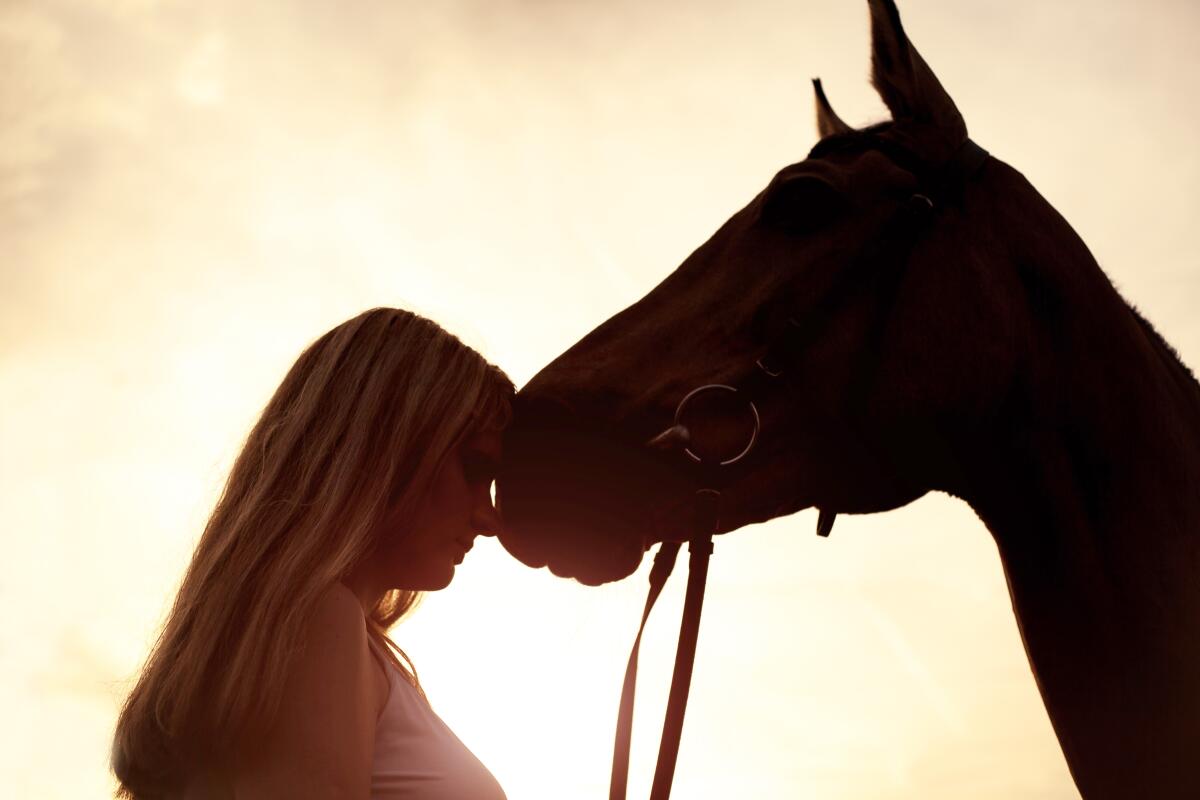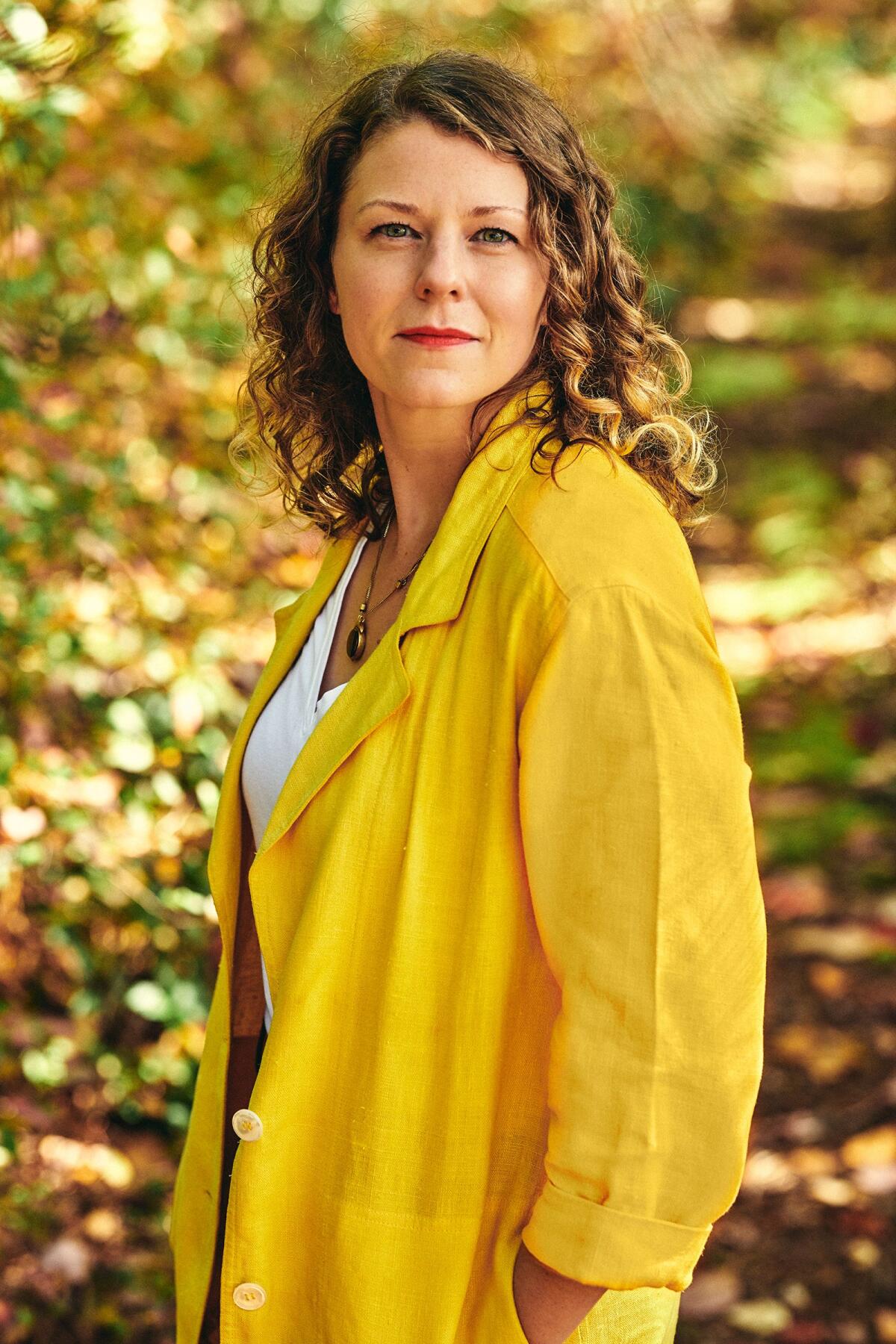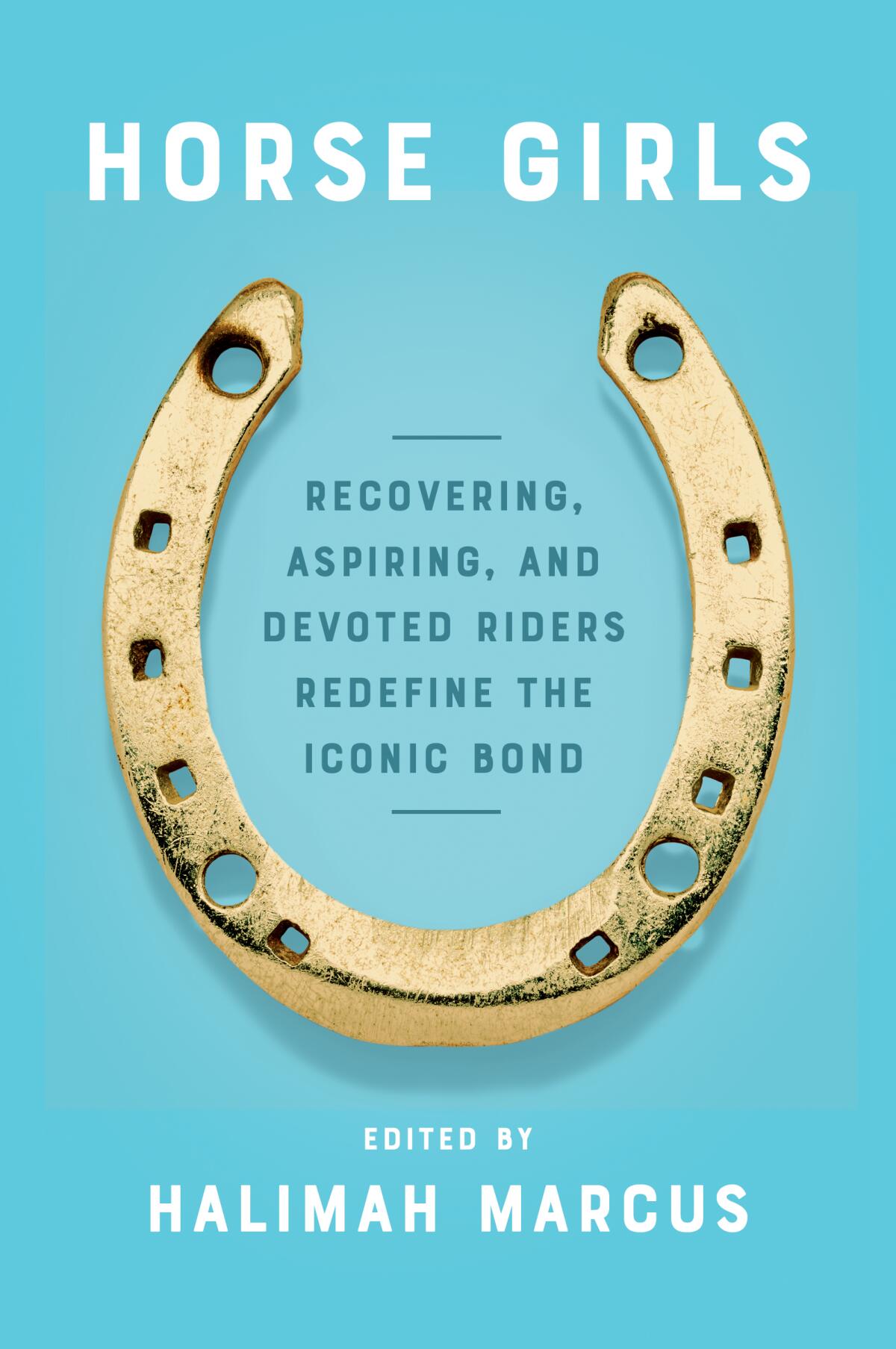
On the Shelf
Horse Girls: Recovering, Aspiring, and Devoted Riders Redefine the Iconic Bond
Edited by Halimah Marcus
Harper Perrennial: 304 pages, $17
If you buy books linked on our site, The Times may earn a commission from Bookshop.org, whose fees support independent bookstores.
Before reading the outstanding anthology “Horse Girls,” edited by Halimah Marcus, I had always puzzled over my time with horses in rural Alabama. From ages 5 to 10, I had cut kudzu trails with Brownie, the smallest of my neighbor’s equine rescue animals. To break me in, Mrs. Cook and I rode bareback with no helmets, nothing but a few pointers (heels down, back straight). I didn’t know enough to be scared. One day, I thought, I’d get to ride Mrs. Cook’s biggest horse, Cinnamon, who bridled with opinions and attitude, qualities I was accused of having too much of myself.
I never did get my shot with Cinnamon. At 10, I moved to suburban Chicago where only the most affluent of my friends took lessons at city stables with proper English saddles. Like several of the contributors to “Horse Girls,” I found my equestrian pursuits stymied by my family’s modest income. I quickly forgot about horses and have only ridden a handful of times since. Why then, decades later, do those golden afternoons with Brownie remain some of the most vivid, most carefree memories of my life?
Horse girls are saddled with stereotypes, redolent of “heterosexuality, independence, whiteness, femininity,” as Carmen Maria Machado puts it in her striking contribution. In her introduction, Marcus presents her own list: “an overzealous misfit; a girl with her head in the pastures; a princess devoted to ponies and privilege; a dominatrix with high boots and crop.” What makes “Horse Girls” such a moving read is that it often explodes these ingrained ideas. Horse girls can be queer, nonbinary, Asian or Black or Latinx or multiracial. They can be middle class (like me) or poor. Even when a horse girl looks like an ‘80s Ralph Lauren ad, there’s always more to the story.
After reading “Horse Girls,” I see my time in Alabama as a wild education in womanhood and equines, inextricably linked. In her essay “For the Roses,” Allie Rowbottom writes that “like it or not, our bodies define what we’re considered capable of. Embodiment is a burden, a history, we can’t escape; horses, valued or discarded for their bodies depending on situation and cultural mood, remind us of ourselves.”

To reckon with the treatment of horses is to grapple with a world that wants to both enshrine and shatter women. Are women witches or servile tools for procreation? Are horses powerhouses that could crush us in one stomp, or are they slaves to industry, war and other human whims? The heartbreaking answer is, of course, both. Has any creature borne the burden of this historic dichotomy as long and painfully as the horse? Has anyone looked at these power dynamics more closely than a horse girl?
Horses are symbols and stories — some banal, others sublime. T Kira Madden, who trained as a hunter jumper, barrel racer and jockey, has no patience for cocktail-party horse stories.
“When I am in the presence of the basic Horse Story, a rage thickens in me,” Madden writes in her charged and conflicted essay, “I Don’t Love Horses.” “You don’t deserve that story, I think. You don’t even know.” But Madden, whose wife is a horse trainer, also understands that stories are never that simple — a horse is never just a horse. “I want so badly not to love them, to step out of the problem.” Instead, she writes into her possessive horse love, which led her back to riding after quitting at 13.
The sport of horse-riding often entails sacrifices; one theme of the collection is reckoning with the costs. C. Morgan Babst’s stunning “Turnout” is one of a few essays to discuss disordered eating alongside show riding. Babst is the daughter of a serious horsewoman who won prizes by demurely riding sidesaddle — and other times appearing in drag as a man. “Beauty came at a cost — that much was clear — but you had to be beautiful to win,” Babst’s mother taught her while supergluing the girl’s ears before a show. What a relief when, as an adult, Babst takes the too-tight bespoke boots she wore as a starved teenager and severs with a knife “the lovely hand-sewn stitches, [setting] my body free.” The release was so triumphant I almost stood up in bed and applauded.
In “Hungry and Carefree,” Alex Marzano-Lesnevich reclaims a 1928 lesbian classic, “The Well of Loneliness” by Radclyffe Hall, as a tale of trans freedom, one of the many cultural texts that help illuminate their time with their beloved childhood horse, Carefree. Despite “the pleasure of forgetting my body when he ran,” Marzano-Lesnevich resists the impulse to define their horse story as one of gender liberation. Instead, Carefree and the author are bonded by all that was left behind.
“The girl I was is just as much an artifact of history as anyone I can uncover in a book,” Marzano-Lesnevich writes. “Just as mysterious to me. Just as gone. In her place, I imagine Carefree. We do with animals what we do with the past: project our hopes onto them, our human feelings and failings.”
In “Unconquered,” one of several essays to rightfully reset the horse’s relationship with groups outside the white elite, Braudie Blais-Billie, born to a Seminole father and a mother from Quebec, thinks back to the love of horses she shared with her white grandparents. Their family rides were a balm for “the wound that their casual othering left behind.” In adulthood she learns that she descends from a horse-riding Seminole dynasty, building a bridge back to her late father, who painfully self-destructed on the Rez.

Over the last few years, American culture has become fascinated with Black cowboys and cowgirls, who have turned up at Black Lives Matter protests and in Lil Nas X’s “Old Town Road” video. Sarah Enelow-Snyder grew up a Texas barrel racer, competing in 4-H Club competitions that wouldn’t have allowed her to race against white girls only 30 years prior. Subjected to classmates’ racism, she opted for home-schooling. As an adult, she is floored by the Instagram accounts Outdoor Afro and Cowgirls of Color. “I wondered what my childhood would have been like if… I could have seen girls on horses who didn’t look or perform like archetypal rodeo queens,” she writes.
Many essays in “Horse Girls,” like Courtney Maum’s memorable “Playing Safe,” set in Mexico during the pandemic, concern adults rediscovering riding after a long absence. It’s staggering to imagine Jane Smiley, mother of all horse-girl writers, taking a break from riding for 25 years only to return at 43 with three young children and eight books under her belt, and she affectionately writes about several as if they’re her children.
For Smiley, it’s all about an intimate emotional connection with the animal. We should all be so lucky to know anything, or anyone, so well.
What makes a grown woman return to horses? The snare of adulthood — embodied in Maum’s depression or Smiley’s sheer overcommitment — often demands simplification, a great stripping-back. In those moments, we ride again for the feeling, and nothing more. I was last on a horse about eight years ago in Big Sur. I was humbled by how terrifying it was to be on top of a massive animal, at its mercy. I treasured the experience but thought I never wanted to repeat it — until I read this book. Now I’m itching to know that freedom and fear again.
Wappler is a writer in Los Angeles.